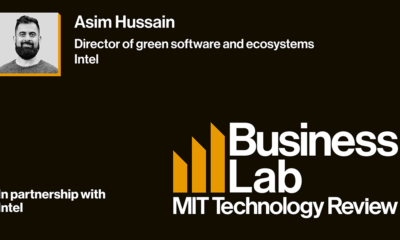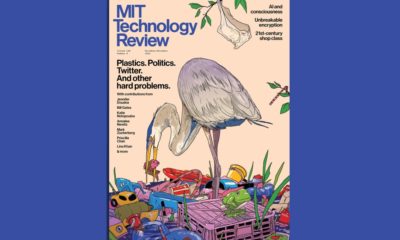Politics
How Software Solves the Modern-World Problems
Published
2 years agoon
By
Drew Simpson
As Hackernoon reports, “Over the past few years, software has transferred all-important life processes to the digital environment, which helps to solve problems in various industries efficiently and quickly.”
Most developers don’t just think about writing code but try to create practical applications to help people, animals, and the planet. To understand how digital technology has changed our lives, it is necessary to become familiar with real-world problems being solved with software.
Software that Solves People’s Problems
The IT industry is becoming more and more in demand, and app usage is growing every day without forecasts of slowing down in the future. According to Statista, there are over 6.3 billion smartphone users worldwide. In the app stores, you can find an application for almost any need:
- sports and nutrition;
- health and spiritual development;
- counting finance and online banks;
- taxi service and delivery;
- booking tickets, hotels, restaurants, etc.
They made a real revolution in the world and helped people separate time from routine tasks and do more valuable things. However, there is a special section of applications that solves serious problems for people. They positively influence our health and help monitor the body efficiently.
Software for Doctor Online Visiting
With the onset of a pandemic that has changed almost the world’s way of life, many services have moved online. Medical services were no exception; they offered patients two options for assistance: consultation with a doctor via audio or video communication and answering questions by specialists in chat or undergoing remote diagnostics using special devices (for example, measuring and controlling heartbeat).
Software for Online Psychological Therapy
It often happens that a solution in a difficult psychological situation is not always possible to find on your own, you do not want to discuss it with friends, and there is no time for a psychotherapist, and sometimes even money. To help a person cope with such problems, companies annually develop and improve virtual helper: applications that provide support and assistance. Conforming to MarketWatch, the top 20 mental health apps in the US were downloaded by 4 million users for the first time in April 2020. An online specialist will help relieve stress, sort out a relationship with a partner, find a common language with a child, and much more. For example, Siri, Apple’s virtual assistant, will call the rescue service if it recognizes a suicidal orientation in a question.
The application My Pocket Therapist brings together therapists from all over the UK and allows them to consult patients online.
It is a very convenient platform that helps you find the right therapist, make an appointment and conduct a video session in real-time. Patients can book sessions, pay, and leave reviews. Doctors create profiles, schedule appointments and receive payments with no effort.
Of course, apps won’t replace going to the hospital, making medical services more accessible. They can also relieve patient flows during a pandemic, screening out people with minimal symptoms. However, for services to truly help people, they must be functional, convenient, secure, and contain legal information.
Software for People with Disabilities
Simple actions such as talking on the smartphone, going downstairs, or even determining the expiration date of groceries in a store can become difficult for people with disabilities. However, some of these problems can be successfully dealt with using an app:
- Roger Voice. It is software that deaf people can use to talk to their interlocutors on smartphones. This app uses speech recognition technology to convert voice to text so deaf people can read what the other person is telling them.
- HearYouNow. With this application, deaf and hard-of-hearing users can adjust the sound according to their situation: public places, meetings, etc. To do this, they need to connect headphones to the smartphone, through which sound is supplied with appropriate settings to optimize the background or foreground. Developed by a Dutch hearing aid manufacturer, the app is intended for people who can use hearing aids but are not ready for it.
- Be My Eyes. It is a crowdsourcing application that, using video chat, connects blind people and volunteers who are ready to help them in various everyday situations, for example, checking the expiration date of products or crossing the street.
- Look At Me. The app developed by Samsung helps children with autism to socialize successfully. The app teaches them to make eye contact, recognize emotions, remember faces, and better express their feelings through game interaction.
Developers are constantly coming up with new software to help those in need. With these applications, anyone can feel like a full-fledged unit of society and not feel different.
Software for Online Workout
Most people know that workout is good for their health, but only a tiny fraction follows the doctors’ recommendations. In today’s world, you don’t have to go to a gym in bad weather – you can use apps on your phone. With the best trainers and personalized technology, a workout at home can be as effective as at the gym. The app store has strength training and cardio options, crossfit and stretching programs, yoga, meditation, and more.
For example, Nike has created an app that contains over 180 exercises from coaches in these categories. At Nike Training, anyone “can create a 4-week fitness program based on their personal goals. Whether you want to get lean or get stronger, you can choose your preferences, add your level of experience, and Nike Training takes care of the rest, choosing from a variety of workouts that fit.” You can train with your weight at home or with additional equipment in the gym.
But Seven has become a real discovery among healthy software. If you have seven minutes a day to do fitness anywhere without requiring any equipment, this app will help you see the first results. With research-based workouts, Seven is designed to get the most out of it in no time. “The 7-minute workout is a high-intensity interval training program. In total, you do 12 exercises, each for 30 seconds, with a break of 10 seconds. Activities include push-ups, triceps lifts, squats, and crunches. Just choose a goal: get in shape, lose weight or get strong and you can start.”
Software for Diets and Nutrition Improvement
As digital services spread to all segments of the population, the need for nutrition control applications has emerged. These mobile nutrition apps help you track your diet and manage food intolerance to boost energy, avoid mood swings and keep your day on track.
FatSecret is one of the most popular calorie counters for iOS and Android. This software is highly functional. The app has food and diet diaries, a diet calendar, Apple Watch integration, Apple Health, Google Fit, Samsung Health, a barcode scanner, reports, and the ability to set goals.
If you want to customize your food, then YAZIO software is a great solution. YAZIO offers customized plans for losing weight or building muscle. Standard functions are food diary, nutritional value calculator, and barcode scanner. The app evaluates the diet, allows you to add new goodies, and monitors proteins and fats.
Software for Delivery
It happens that, for various reasons, a person cannot leave the house and buy the necessary goods. It could be due to illness, busy schedule, or physical ability. In such moments, either close people or digital technologies can help. Food delivery software is popular right now. Fundera forecasts that delivery and online ordering will make $32 billion by 2024.
If you decide to spend time at home today, Glovo will save you. “It is a Spanish startup that delivers groceries, medicine, meals, and more within an hour from restaurants, cafes, shops, markets, and online stores.”
The service stands out from several sizable European delivery services because it offers to bring any small item on demand. The order can be made in the application or on the website. The Glovo platform connects three parties: the user, the business (shops, restaurants, etc.), and independent couriers. The application takes a commission from the cost of goods from partners and a delivery fee from users.
Nowadays, the delivery of goods by drones is gaining popularity. Most companies currently use drones with six or more propellers. The shipping container is placed in a compartment at the bottom of the drone or attached directly to the aircraft itself. The client receives the package by taking it from the drone compartment that has descended to the ground.
Amazon was one of the first to try drones delivering their packages. In December 2016, Amazon Prime Air successfully delivered the package to Cambridge — and as reported in June 2022, Amazon is doing delivery home testing in California.
Why Software Makes Life Easier
Modern software development aims to benefit people and save their time. To get to the doctor, you do not need to wait in line – you can contact them by phone. You don’t have to cook a lot of food because it can be ordered in the app with delivery. You also don’t need to go to the gym: do your workout at home by playing the video. Modern digital solutions allow everyone to live a fulfilling life even in isolation.
If you intend to create your own software, do not forget to implement functions that will be highly appreciated by the inhabitants of your country or even the planet. Thanks to this, you will increase awareness, attract users and tell the whole world about the product.
Image Credit: Photo by Mikhail Nilov; Pexels; Thank you!
Elina Nazarova
Chief Marketing Officer of Powercode
Elina is accountable for digital strategy development and implementation. She is certified in business and startups development and has more than 5 years of experience in content writing and management. Her core belief is that well-designed digital transformation is able to lead any business to success.
You may like
-


Developing climate solutions with green software
-


Tackling our biggest problems
-


What are the hardest problems in tech we should be more focused on as a society?
-


The Download: tech’s hardest problems, and cancer-fighting cell therapies
-


The Download: introducing the Hard Problems issue
-


Heat-storing batteries are scaling up to solve one of climate’s dirtiest problems
Politics
Fintech Kennek raises $12.5M seed round to digitize lending
Published
7 months agoon
10/11/2023By
Drew Simpson
London-based fintech startup Kennek has raised $12.5 million in seed funding to expand its lending operating system.
According to an Oct. 10 tech.eu report, the round was led by HV Capital and included participation from Dutch Founders Fund, AlbionVC, FFVC, Plug & Play Ventures, and Syndicate One. Kennek offers software-as-a-service tools to help non-bank lenders streamline their operations using open banking, open finance, and payments.
The platform aims to automate time-consuming manual tasks and consolidate fragmented data to simplify lending. Xavier De Pauw, founder of Kennek said:
“Until kennek, lenders had to devote countless hours to menial operational tasks and deal with jumbled and hard-coded data – which makes every other part of lending a headache. As former lenders ourselves, we lived and breathed these frustrations, and built kennek to make them a thing of the past.”
The company said the latest funding round was oversubscribed and closed quickly despite the challenging fundraising environment. The new capital will be used to expand Kennek’s engineering team and strengthen its market position in the UK while exploring expansion into other European markets. Barbod Namini, Partner at lead investor HV Capital, commented on the investment:
“Kennek has developed an ambitious and genuinely unique proposition which we think can be the foundation of the entire alternative lending space. […] It is a complicated market and a solution that brings together all information and stakeholders onto a single platform is highly compelling for both lenders & the ecosystem as a whole.”
The fintech lending space has grown rapidly in recent years, but many lenders still rely on legacy systems and manual processes that limit efficiency and scalability. Kennek aims to leverage open banking and data integration to provide lenders with a more streamlined, automated lending experience.
The seed funding will allow the London-based startup to continue developing its platform and expanding its team to meet demand from non-bank lenders looking to digitize operations. Kennek’s focus on the UK and Europe also comes amid rising adoption of open banking and open finance in the regions.
Featured Image Credit: Photo from Kennek.io; Thank you!
Radek Zielinski
Radek Zielinski is an experienced technology and financial journalist with a passion for cybersecurity and futurology.
Politics
Fortune 500’s race for generative AI breakthroughs
Published
7 months agoon
10/11/2023By
Drew Simpson
As excitement around generative AI grows, Fortune 500 companies, including Goldman Sachs, are carefully examining the possible applications of this technology. A recent survey of U.S. executives indicated that 60% believe generative AI will substantially impact their businesses in the long term. However, they anticipate a one to two-year timeframe before implementing their initial solutions. This optimism stems from the potential of generative AI to revolutionize various aspects of businesses, from enhancing customer experiences to optimizing internal processes. In the short term, companies will likely focus on pilot projects and experimentation, gradually integrating generative AI into their operations as they witness its positive influence on efficiency and profitability.
Goldman Sachs’ Cautious Approach to Implementing Generative AI
In a recent interview, Goldman Sachs CIO Marco Argenti revealed that the firm has not yet implemented any generative AI use cases. Instead, the company focuses on experimentation and setting high standards before adopting the technology. Argenti recognized the desire for outcomes in areas like developer and operational efficiency but emphasized ensuring precision before putting experimental AI use cases into production.
According to Argenti, striking the right balance between driving innovation and maintaining accuracy is crucial for successfully integrating generative AI within the firm. Goldman Sachs intends to continue exploring this emerging technology’s potential benefits and applications while diligently assessing risks to ensure it meets the company’s stringent quality standards.
One possible application for Goldman Sachs is in software development, where the company has observed a 20-40% productivity increase during its trials. The goal is for 1,000 developers to utilize generative AI tools by year’s end. However, Argenti emphasized that a well-defined expectation of return on investment is necessary before fully integrating generative AI into production.
To achieve this, the company plans to implement a systematic and strategic approach to adopting generative AI, ensuring that it complements and enhances the skills of its developers. Additionally, Goldman Sachs intends to evaluate the long-term impact of generative AI on their software development processes and the overall quality of the applications being developed.
Goldman Sachs’ approach to AI implementation goes beyond merely executing models. The firm has created a platform encompassing technical, legal, and compliance assessments to filter out improper content and keep track of all interactions. This comprehensive system ensures seamless integration of artificial intelligence in operations while adhering to regulatory standards and maintaining client confidentiality. Moreover, the platform continuously improves and adapts its algorithms, allowing Goldman Sachs to stay at the forefront of technology and offer its clients the most efficient and secure services.
Featured Image Credit: Photo by Google DeepMind; Pexels; Thank you!
Deanna Ritchie
Managing Editor at ReadWrite
Deanna is the Managing Editor at ReadWrite. Previously she worked as the Editor in Chief for Startup Grind and has over 20+ years of experience in content management and content development.
Politics
UK seizes web3 opportunity simplifying crypto regulations
Published
7 months agoon
10/10/2023By
Drew Simpson
As Web3 companies increasingly consider leaving the United States due to regulatory ambiguity, the United Kingdom must simplify its cryptocurrency regulations to attract these businesses. The conservative think tank Policy Exchange recently released a report detailing ten suggestions for improving Web3 regulation in the country. Among the recommendations are reducing liability for token holders in decentralized autonomous organizations (DAOs) and encouraging the Financial Conduct Authority (FCA) to adopt alternative Know Your Customer (KYC) methodologies, such as digital identities and blockchain analytics tools. These suggestions aim to position the UK as a hub for Web3 innovation and attract blockchain-based businesses looking for a more conducive regulatory environment.
Streamlining Cryptocurrency Regulations for Innovation
To make it easier for emerging Web3 companies to navigate existing legal frameworks and contribute to the UK’s digital economy growth, the government must streamline cryptocurrency regulations and adopt forward-looking approaches. By making the regulatory landscape clear and straightforward, the UK can create an environment that fosters innovation, growth, and competitiveness in the global fintech industry.
The Policy Exchange report also recommends not weakening self-hosted wallets or treating proof-of-stake (PoS) services as financial services. This approach aims to protect the fundamental principles of decentralization and user autonomy while strongly emphasizing security and regulatory compliance. By doing so, the UK can nurture an environment that encourages innovation and the continued growth of blockchain technology.
Despite recent strict measures by UK authorities, such as His Majesty’s Treasury and the FCA, toward the digital assets sector, the proposed changes in the Policy Exchange report strive to make the UK a more attractive location for Web3 enterprises. By adopting these suggestions, the UK can demonstrate its commitment to fostering innovation in the rapidly evolving blockchain and cryptocurrency industries while ensuring a robust and transparent regulatory environment.
The ongoing uncertainty surrounding cryptocurrency regulations in various countries has prompted Web3 companies to explore alternative jurisdictions with more precise legal frameworks. As the United States grapples with regulatory ambiguity, the United Kingdom can position itself as a hub for Web3 innovation by simplifying and streamlining its cryptocurrency regulations.
Featured Image Credit: Photo by Jonathan Borba; Pexels; Thank you!
Deanna Ritchie
Managing Editor at ReadWrite
Deanna is the Managing Editor at ReadWrite. Previously she worked as the Editor in Chief for Startup Grind and has over 20+ years of experience in content management and content development.
